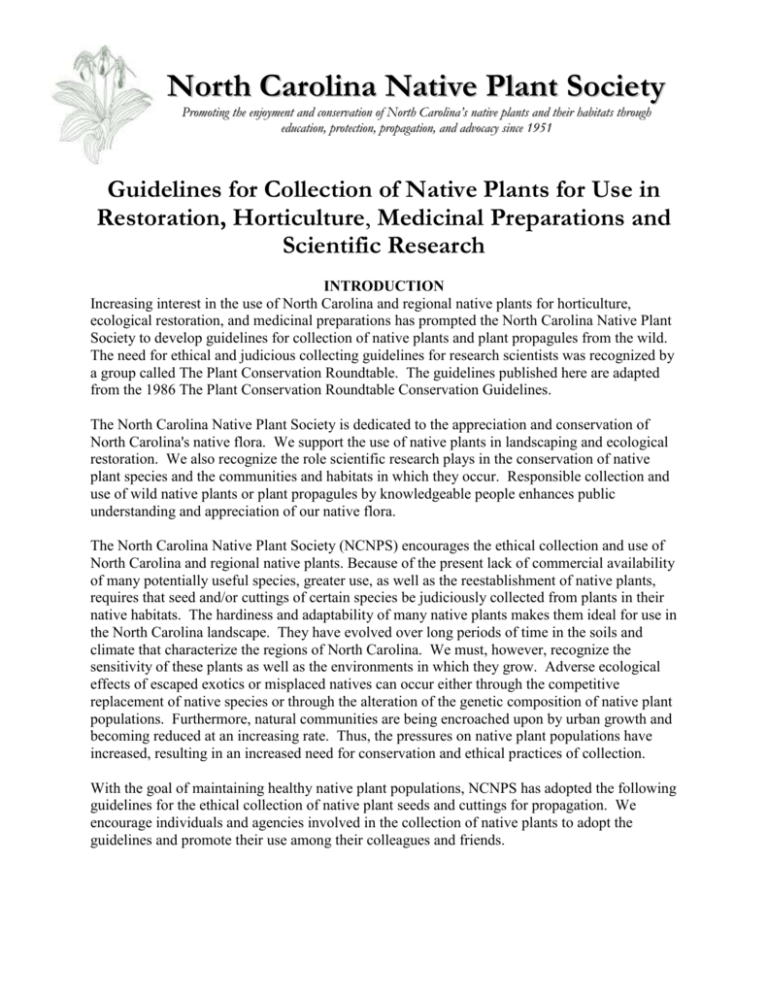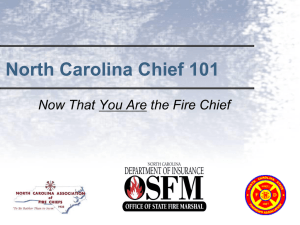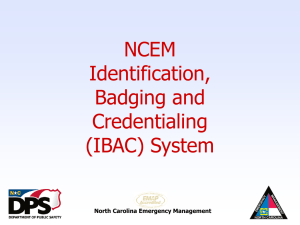Word doc - North Carolina Native Plant Society
advertisement

North Carolina Native Plant Society Promoting the enjoyment and conservation of North Carolina’s native plants and their habitats through education, protection, propagation, and advocacy since 1951 Guidelines for Collection of Native Plants for Use in Restoration, Horticulture, Medicinal Preparations and Scientific Research INTRODUCTION Increasing interest in the use of North Carolina and regional native plants for horticulture, ecological restoration, and medicinal preparations has prompted the North Carolina Native Plant Society to develop guidelines for collection of native plants and plant propagules from the wild. The need for ethical and judicious collecting guidelines for research scientists was recognized by a group called The Plant Conservation Roundtable. The guidelines published here are adapted from the 1986 The Plant Conservation Roundtable Conservation Guidelines. The North Carolina Native Plant Society is dedicated to the appreciation and conservation of North Carolina's native flora. We support the use of native plants in landscaping and ecological restoration. We also recognize the role scientific research plays in the conservation of native plant species and the communities and habitats in which they occur. Responsible collection and use of wild native plants or plant propagules by knowledgeable people enhances public understanding and appreciation of our native flora. The North Carolina Native Plant Society (NCNPS) encourages the ethical collection and use of North Carolina and regional native plants. Because of the present lack of commercial availability of many potentially useful species, greater use, as well as the reestablishment of native plants, requires that seed and/or cuttings of certain species be judiciously collected from plants in their native habitats. The hardiness and adaptability of many native plants makes them ideal for use in the North Carolina landscape. They have evolved over long periods of time in the soils and climate that characterize the regions of North Carolina. We must, however, recognize the sensitivity of these plants as well as the environments in which they grow. Adverse ecological effects of escaped exotics or misplaced natives can occur either through the competitive replacement of native species or through the alteration of the genetic composition of native plant populations. Furthermore, natural communities are being encroached upon by urban growth and becoming reduced at an increasing rate. Thus, the pressures on native plant populations have increased, resulting in an increased need for conservation and ethical practices of collection. With the goal of maintaining healthy native plant populations, NCNPS has adopted the following guidelines for the ethical collection of native plant seeds and cuttings for propagation. We encourage individuals and agencies involved in the collection of native plants to adopt the guidelines and promote their use among their colleagues and friends. The North Carolina Native Plant Society's Collection Guidelines are intended to apply to collection of North Carolina and regional native plants, plant parts, or plant propagules for use in horticulture, ecological restoration, medicinal preparations, and scientific research. 1. Know which plant species in North Carolina and the Southeastern region are Threatened, Endangered, Sensitive, or Species of Special Concern. Such plants should not be collected. If special circumstances exist, such as imminent destruction of habitat (salvage operations), scientific research contributing to long-term conservation of the species, or reestablishment of extirpated populations, use care and judgment in collecting only what is necessary. Contact the North Carolina Plant Conservation Program, NC Natural Heritage Program, or U.S. Fish and Wildlife Service for current status information. 2. Obtain necessary permits and permission for collecting on public lands. Collecting is prohibited by regulation on some public lands. Public land management agencies require a Special Use Permit (the U.S. Forest Service, for example). Know and abide by all regulations. Report any illegal collecting that you observe to appropriate authorities. 3. If you intend to collect on private land, obtain permission from the landowner beforehand. It is best to get written permission, in case you should be questioned about your activities in the future. 4. Do not collect indiscriminately, even in large populations. Collect only the minimum amount of plant material necessary. Take into account the cumulative effects of multiple collections on survival and reproductive success of the plant population. Never collect the only plant at a given location. A general guideline is one collection for every 20 to 50 plants. 5. Do not collect whole plants when plant parts (e.g., seeds or cuttings) are sufficient. 6. Know when collection of a voucher specimen is appropriate. Record all data required by the institution where you intend to deposit the voucher at the time the collection is made (i.e., in the field). Herbaria associated with the University of North Carolina System, such as The Herbarium at the University of North Carolina, http://herbarium.unc.edu/ or the North Carolina State University Herbarium http://www.cals.ncsu.edu/plantbiology/ncsc/history.htm are recommended as repositories for plant materials collected in North Carolina. If another institution is chosen, it should be a publicly accessible institutional herbarium recognized by the International Association of Plant Taxonomists (listings are published in Index Herbariorum). 7. Collect only if you are (or are accompanied by) a trained individual. Care properly for the specimens you collect, whether they are intended for preparation as herbarium specimens or as propagation materials. Keep a permanent record of your collection activities. Complete records of location, habitat, collectors, and date should be transferred with plant materials whenever they change hands. Collect discreetly so as not to encourage others to collect indiscriminately. Be prepared to explain what you are doing and why. 8. Respect and protect habitat. Avoid trampling vegetation or other sensitive features. Stay on designated trails wherever possible. Do not collect from areas that are vulnerable to erosion (trailside areas, for example). The standard rule is to leave no trace of your visit; avoid damage to the site and its natural and aesthetic values. 9. If you discover a new plant record (such as a new population of a rare species, or the first observation of a species within a given county), notify an appropriate conservation official with one of the agencies listed in #1, or land manager. Be cautious in providing site locations of rare plants to others. A rare plant survey form can be found at http://www.ncnhp.org/Pages/heritagedata.html 10. If you learn that rare or protected plant species or their habitats may be destroyed, notify a North Carolina Native Plant Society board member or North Carolina Natural Heritage program, http://www.ncnhp.org/ or North Carolina Plant Conservation program, http://www.ncagr.com/plantindustry/plant/plantconserve/index.htm. 11. Conduct salvage (rescue) projects only in sites that are scheduled for imminent destruction Obtain prior permission of the landowner. Do not collect from portions of the site that will remain in a natural state. Use salvaged plants only for such purposes as relocation, public education, botanical research or documentation, or propagation as stock. At the current time, plants collected during organized NCNPS salvage efforts are not to be made available for sale by commercial outlets. Plants may be sold to the public by NCNPS at plant sales and plant auctions. 12. Purchase of wild-collected plants (or plant parts) of rare or protected taxa is discouraged... Beware of wild-collected plants advertised in commercial seed and bulb catalogues, or sold in the form of medicinal herbal preparations or other products. Be informed and watchful. The word "wild-crafted”, which is found on many medicinal herbal preparations, means the herbs were collected from the wild. If you are not sure that the plants or products were collected following sustainable practices, do not purchase them. 13. When discussing or publishing research results or preparing horticultural, promotional or educational materials, describe conservation considerations underlying your collecting techniques. 14. If you are involved in education, teach your students about proper and careful collecting. When taking students into the field, visit only non-sensitive areas, taking care not to trample the site. Avoid frequent visits to the same natural site. For classroom use, collect only those plants both common in the region and locally abundant at the site. Whenever possible, collect only the portions of a plant necessary for identification, such as leaf, flower, or fruit.








